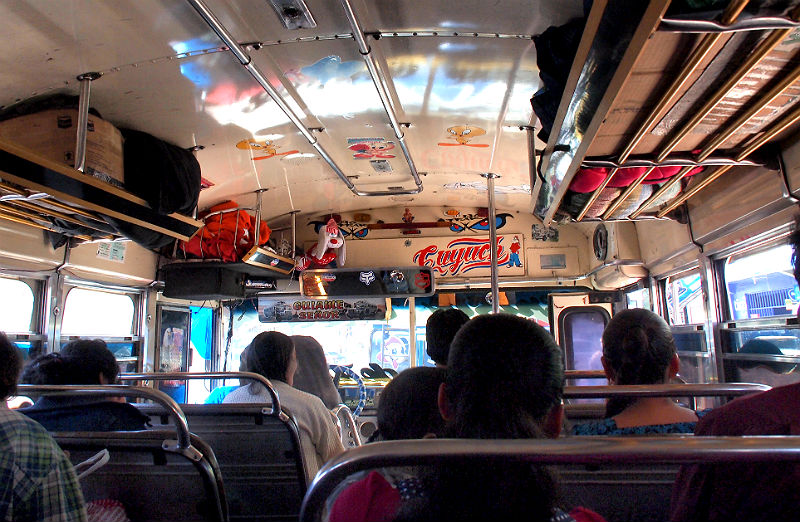From Todos Santos onward to Quetzaltenango and beyond, we always used "chicken buses." These are old U.S. and Canadian schoolbuses, imported to Guatemala and given a new lease on life. We think they're called "chicken buses" because rural people sometimes use them to bring chickens or other critters to market. In fact, we didn't see livestock of any sort on the buses we rode.
Inside, these still look like the Bluebird school buses that they are, though with the addition of religious images and signs like "Guide Me, Lord" and "Jesus Lives." Or depending on the driver's religious convictions, there may be stuffed animals and cartoon characters. (Or both - see photo below!) The buses can be super crowded - six people across with more standing.
On the outside, these buses are often laden with chrome and painted in dazzling colors. In fact, if a few of these amazing chicken buses were to appear in a U.S. city, people would flock to admire them!
Barbara commented, rightly, that traveling on a chicken bus is like riding around in a work of art.
Another pleasure of riding the buses, for us anyway, was being up close with the local people They were remarkably friendly and cheerful. We wondered why a tourist would pay lots more to ride in a van packed with other tourist rather than enjoying an authentic slice of life aboard a chicken bus.
We rode a bus bus from Todos Santos to Huehuetenango and continued to Quetzaltenango, Xela, the same day. The enire trip was only a few hours and we arrived in late afternooon.
Xela is Guatemala's second largest city, in the highlands and surrounded by mountains. There is a handsome central square, a lively center of the city's life.
When we arrived, we were disappointed to learn that the hostel where we'd hoped to stay was full. We eventually found Casa Dona Mercedes, below. It seemed more expensive than we wanted, but it turned out that the weekly rate was much better. It was a comfortable place to stay with friendly owners and guests, and a kitchen and dining area so people could fix some of their own meals. We ended up staying a week.
 |
| Outside Casa Dona Mercedes; our room |
 |
| Guests' dining area, kitchen out of sight to the right; the friendly owners |
Seen on Walks Around Town


Though Quetzaltenango was quite livable for a city, we were anxious to visit some of the smaller villages surrounding it. On three separate days, we rode buses out and back to three villages: Zunil, Totonicapan, and San Andres.
Zunil
Zunil was a smallish village with two principal surprises for us. First was the cemetery -- a huge hilltop city of the dead in a spectacular setting above the village. It was the site of a large gathering when we were there. We should have found out what the occasion was, but we didn't.
 |
| Zunil |
 |
| Walking toward the cemetery |
 |
| Cemetery in a spectacular setting |
 |
| Many visitors to the cemetery brought picnics. |
 |
| Restoring and painting the facade of Zunil's beautiful old church |
The second surprise for us in Zunil was the women's crafts co-op. They had a handsome, modern shop with high-quality items handcrafted locally. It was impressive.
 |
| Women's headstrap in the crafts co-op |
 |
| A highly decorated headstrap; hand-woven, hand embroidered huipile |
Totonicapan
The next village that we visited was Totonicapan. It is said to have one of the biggest markets around, and unlike the famous market in Chichicastenango, it is not a tourist-driven affair. However the market, not catering to tourists, focused mainly on practical goods -- inexpensive housewares, food, clothing. None of it was particularly interesting to us, but the town itself looked clean and relatively prosperous, with some handsome parks and buildings.
San Andres Xecul
This village is famous for its spectacular church, the facade of which is a tour-de-force of folk art. There was a small outdoor market in the plaza in front of the church.

 |
Shopping
|
Seen Around Town
San Andres is built in the hills, with steps to the higher-up neighborhoods. Looking down, we saw signs of a local industry: spinning and dying thread, which is dried on the roofs.
At a mirador (viewpoint) above town there is a cute chapel, built in a simpler style but resembling the landmark church below. Beside the chapel is a Mayan altar, clearly showing the syncretist nature of much contemporary Mayan worship. The sign says that this altar is built on the site of a cemetery where some of the earliest resident are buried, and it asks visitors to be respectful of this heritage by obeying a few rules like not littering, not standing or sitting on the altar, and being careful with fires.
 |
| In the cemetery |
 |
| San Andres seen from the cemetery |
Continue to Chichicastenango and Atitlán >>


















































